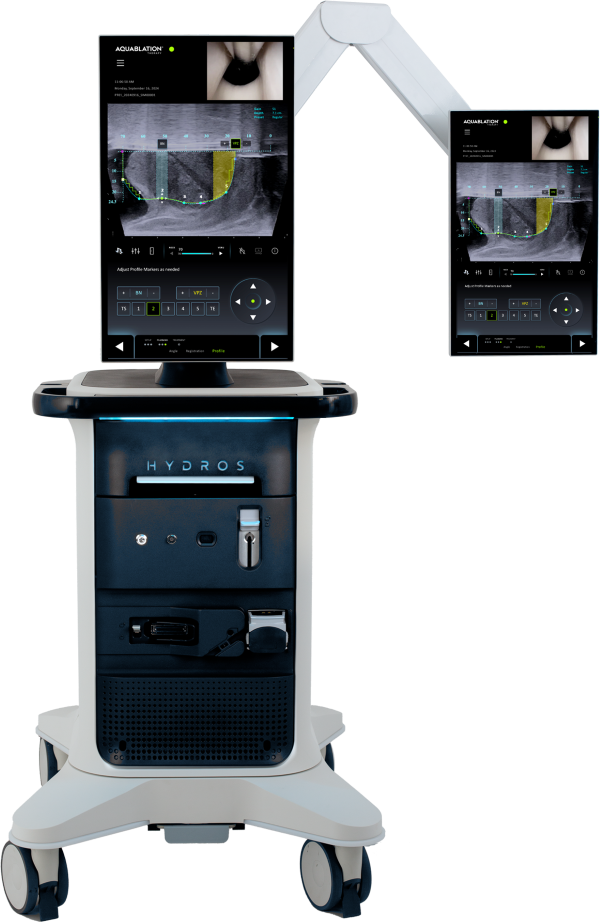Menu
First in Michigan, First for You: Advanced Enlarged Prostate Relief with Aquablation Therapy
Aquablation therapy is the only real-time, ultrasound-guided, robotic-assisted, heat-free waterjet for the treatment of enlarged prostates also known as benign prostatic hyperplasia (BPH). At Aspire Rural Health System, we are proud to offer this advanced, minimally invasive treatment at Marlette Regional Hospital. The HYDROS™ Robotic System is designed to deliver an accurate and consistent treatment plan for better clinical outcomes.
Aquablation therapy is a resective procedure, which means that the prostate tissue causing symptoms is surgically removed. No incision is made in the abdomen, as the prostate is reached through the urethra.
Aquablation therapy is performed in a hospital. You will be under anesthesia for the entire procedure. The procedure typically takes an hour and may involve an overnight stay.
There are two key steps to the Aquablation therapy procedure:
Every prostate is unique in size and shape. Aquablation therapy enables our surgeons to customize your procedure to your specific anatomy.
How? Aquablation therapy is the only enlarged prostate surgical procedure that combines next-generation ultrasound imaging and digital cystoscopy. With the help of ultrasound imaging, surgeons can create a detailed guide to plan the procedure, outlining the critical anatomy and suggest an optimal treatment plan for each patient. The tissue within the marked area of the prostate may be removed, while the tissue outside of it may remain untouched. This real-time visualization allows your surgeon to map which parts of your prostate to remove and which parts to avoid, specifically enabling him/her/them to avoid removing areas that could cause irreversible complications like erectile dysfunction, ejaculatory dysfunction, and incontinence.
Once your surgeon has created a surgical map, a robotic-assisted heat-free waterjet follows the surgeon-defined treatment plan and resects the obstructive tissue. This advanced technology helps ensure precise, consistent, and predictable removal of the tissue across a wide range of prostate sizes and shapes. When required, your surgeon may use a minimal amount of cautery following an Aquablation therapy procedure to control bleeding.
Aquablation therapy is a different kind of surgical procedure. There are many reasons it may be right for you, but make sure to discuss with our surgeons to see if you’re a candidate.1-2
Aquablation therapy has a very low rates of irreversible complications (incontinence, ejaculatory dysfunction, erectile dysfunction) because:1-2
Aquablation therapy is the only procedure that resects prostate tissue with a robotically controlled waterjet, designed to minimize human error.
In clinical studies, Aquablation therapy has been shown to provide long-term relief at 5 years.1,2
When compared with transurethral resection of the prostate (TURP), Aquablation therapy demonstrated:5
Aquablation therapy patients on average experienced:1-3
Take the International Prostate Symptom Score (IPSS) Quiz to measure how severe your symptoms are.
Take the Sexual Function Quiz to help you determine if maintaining sexual function after BPH surgery is important to you.

As with most benign prostatic hyperplasia procedures, you will wake up with a catheter following Aquablation therapy, which allows you to urinate while your urethra heals. The procedure may involve an overnight stay in the hospital. The benefit with Aquablation therapy is that most patients end up leaving the hospital without a catheter.1,2,4
Once you’re home, you may notice for several weeks a mild burning sensation and urinary urgency, a sudden and intense need to urinate that is difficult to hold off. This can be managed with mild pain medication. Patients can resume their normal activities once approved by their doctor.
Please refer to the discharge instructions provided by your surgeon.
For more information, visit https://aquablation.com/safety-information/
Aspire Urology Clinic
2750 Main St., Suite 7/8
Marlette, MI 48453
Phone: 989-912-6581
To stay up to date on all things related to Aquablation therapy, visit Aquablation.com or follow Aquablation therapy on Facebook and Twitter.
https://aquablation.com/safety-information/
© 2024 PROCEPT BioRobotics Corporation. All rights reserved. AQUABLATION, HYDROS, PROCEPT BioRobotics, and the PROCEPT BioRobotics logo are trademarks and/or registered trademarks of PROCEPT BioRobotics Corporation
ML0661.A
© 2025 Aspire Rural Health System